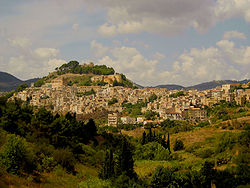Calatafimi
| Calatafimi-Segesta | ||
|---|---|---|
| Comune | ||
| Comune di Calatafimi-Segesta | ||
 |
||
|
||
| Location of Calatafimi-Segesta in Italy | ||
| Coordinates: 37°54′N 12°51′E / 37.900°N 12.850°E | ||
| Country | Italy | |
| Region |
|
|
| Province / Metropolitan city | Trapani (TP) | |
| Frazioni | Sasi | |
| Government | ||
| • Mayor | Vito Sciortino | |
| Area | ||
| • Total | 154 km2 (59 sq mi) | |
| Elevation | 338 m (1,109 ft) | |
| Population (2015) | ||
| • Total | 6.712 | |
| • Density | 0.044/km2 (0.11/sq mi) | |
| Demonym(s) | Calatafimesi | |
| Time zone | CET (UTC+1) | |
| • Summer (DST) | CEST (UTC+2) | |
| Postal code | 91013 | |
| Dialing code | 0924 | |
| Patron saint | Most Holy Crucifix and Madonna of Giubino | |
| Saint day | May 3rd | |
| Website | Official website | |
Calatafimi-Segesta (Sicilian: Calatafimi-Seggesta) is a small town, more popularly known simply as Calatafimi, in the Province of Trapani, in Sicily, southern Italy.
The full name of the municipality was created in 1997 and is meant to highlight the presence within its territory of the 5th century B.C. Doric temple of Segesta, widely regarded as one of the most intact of its type. Adjoining the temple, on a nearby hilltop, there is a 2nd-century Roman amphitheater.
The town developed during the age of the Muslim emirate of Sicily, when it was known as Qal`at(a)fīmī ( قلعة فيمي ), referring to the defensive castle overlooking the town, now partially restored from ruins. One hypothesis for the castle's name derives it from "Castrum Phimes" - a stronghold protecting the territory of a Roman period nobleman mentioned by Cicero, Diocles Phimes. Another hypothesis derives it from "Castle of Euphemius", possibly referring to the 5th century Byzantine patriarch by that name or, more likely, to the 9th century Euphemius of Sicily, a legendary figure who probably brought Muslim mercenaries to Sicily in 827 to help defend his throne, only to have them conquer the island for themselves.
Calatafimi's part of Sicily was one of the first to be occupied by the Aghlabids from Ifriqiya in their conquest of the island, and was one of the last centres of Islamic culture after the end of the Norman rule. The excavations near Segesta have revealed a 12th-century Islamic necropolis and mosque. There are also references to an Islamic-period town called Calathamet (Qal`at al-Hammah - قلعة الحمّة), on the border of the territories of Calatafimi and Castellammare del Golfo, possibly equating the modern Terme Segestane.
From 1336 until 1860, Calatafimi was a feudal territory under Habsburg and Spanish nobles, despite three attempts to regain an independent status (in 1399, 1412 and 1802).
It was on a hill near Calatafimi, called Pianto Romano, that, in 1860, Giuseppe Garibaldi and his Mille first encountered the troops of the Bourbons on a battlefield (see the Battle of Calatafimi). This was the first significant battle for the Italian unification (or Risorgimento) and it was in this battle that Garibaldi was said to have uttered the famous battle cry: "Here we make Italy, or we die" (in Italian "Qui si fa l'Italia, o si muore"). A memorial, in the form of large stone obelisk containing an ossuary of the remains of those fallen in the battle, currently marks the hilltop.
...
Wikipedia


